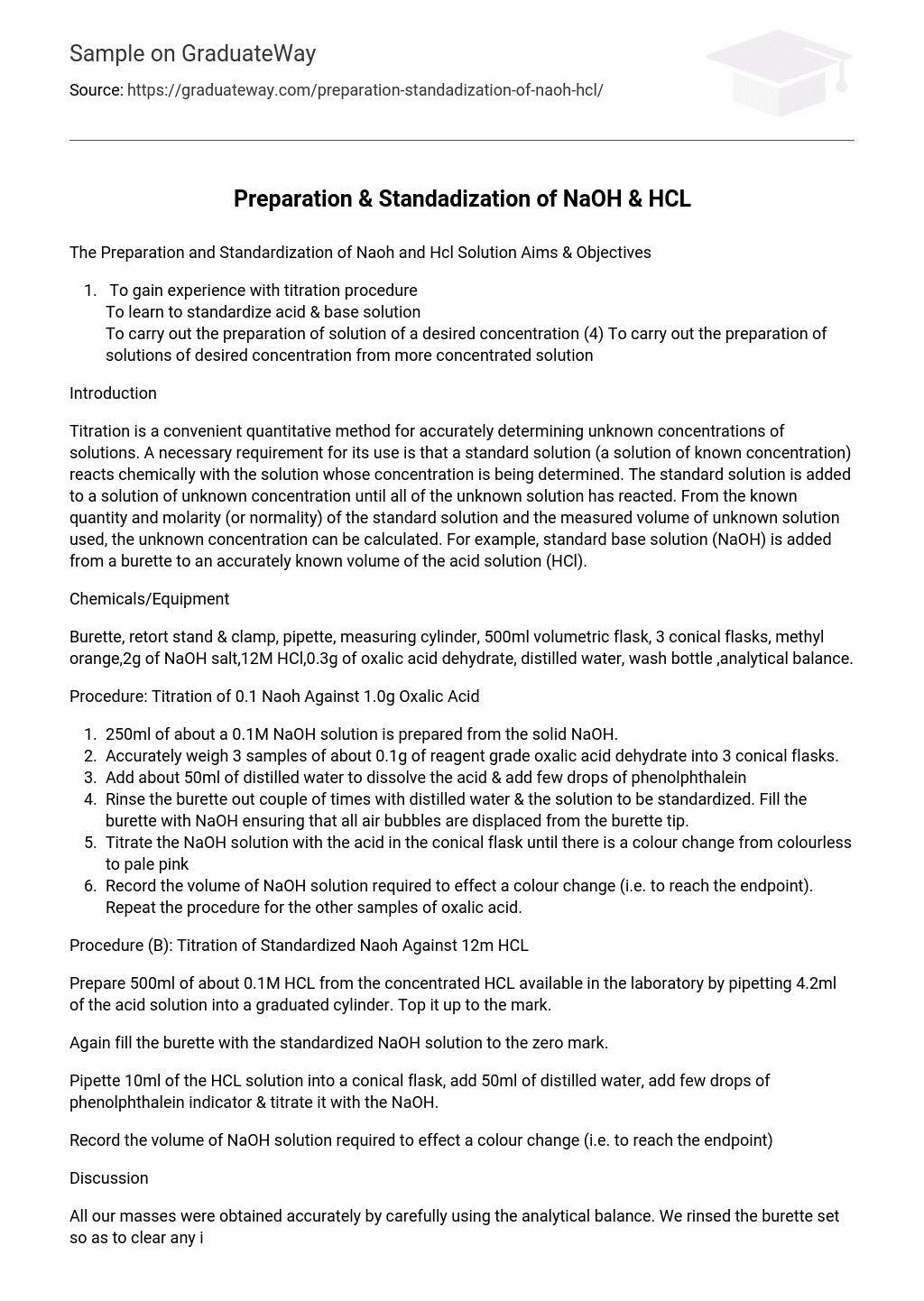The Preparation and Standardization of Naoh and Hcl Solution Aims & Objectives
- To gain experience with titration procedure
To learn to standardize acid & base solution
To carry out the preparation of solution of a desired concentration (4) To carry out the preparation of solutions of desired concentration from more concentrated solution
Introduction
Titration is a convenient quantitative method for accurately determining unknown concentrations of solutions. A necessary requirement for its use is that a standard solution (a solution of known concentration) reacts chemically with the solution whose concentration is being determined. The standard solution is added to a solution of unknown concentration until all of the unknown solution has reacted. From the known quantity and molarity (or normality) of the standard solution and the measured volume of unknown solution used, the unknown concentration can be calculated. For example, standard base solution (NaOH) is added from a burette to an accurately known volume of the acid solution (HCl).
Chemicals/Equipment
Burette, retort stand & clamp, pipette, measuring cylinder, 500ml volumetric flask, 3 conical flasks, methyl orange,2g of NaOH salt,12M HCl,0.3g of oxalic acid dehydrate, distilled water, wash bottle ,analytical balance.
Procedure: Titration of 0.1 Naoh Against 1.0g Oxalic Acid
- 250ml of about a 0.1M NaOH solution is prepared from the solid NaOH.
- Accurately weigh 3 samples of about 0.1g of reagent grade oxalic acid dehydrate into 3 conical flasks.
- Add about 50ml of distilled water to dissolve the acid & add few drops of phenolphthalein
- Rinse the burette out couple of times with distilled water & the solution to be standardized. Fill the burette with NaOH ensuring that all air bubbles are displaced from the burette tip.
- Titrate the NaOH solution with the acid in the conical flask until there is a colour change from colourless to pale pink
- Record the volume of NaOH solution required to effect a colour change (i.e. to reach the endpoint). Repeat the procedure for the other samples of oxalic acid.
Procedure (B): Titration of Standardized Naoh Against 12m HCL
Prepare 500ml of about 0.1M HCL from the concentrated HCL available in the laboratory by pipetting 4.2ml of the acid solution into a graduated cylinder. Top it up to the mark.
Again fill the burette with the standardized NaOH solution to the zero mark.
Pipette 10ml of the HCL solution into a conical flask, add 50ml of distilled water, add few drops of phenolphthalein indicator & titrate it with the NaOH.
Record the volume of NaOH solution required to effect a colour change (i.e. to reach the endpoint)
Discussion
All our masses were obtained accurately by carefully using the analytical balance. We rinsed the burette set so as to clear any impurities in the burette that may interfere with our results. Since the standard volume is 1000ml & the question demands that we use 500ml which is half the standard volume, we divided the mass of NaOH by 2. Therefore 2g of NaOH salt was used in preparing the solution. Our endpoint was marked by an immediate colour change i.e. from colourless to pale pink, which lasted for more than 30 seconds
Sources of Error
- The breath of students around the analytical balance.
- The burette which has no stripe painting for reading of meniscus. (3) Differences in the titre values may perhaps be due to spilling of the oxalic acid whiles transferring to the flask.
Precaution
- Care was taken to displace all air bubbles from the burette tip.
- Water was added to the acid whiles stirring & not vice versa.
- The burette was well clamped to the retort stand & the burette lowered enough so that splatter from the sample does not exit the flask as titration went on.
- The solution in the conical flask was swirled whiles titration went on.
- No more NaOH solution was added when the end point was reached
- The solid NaOH was immediately used after weighing and was always kept covered as it easily absorbs water from the atmosphere.
- It was ensured that the titre vale was read from the bottom of the meniscus
Conclusion
The experimental procedure used in preparing the standardized solutions proved to be a successful as there was only a slight deviation (change) from the actual value & thus was consistent in obtaining standard solutions
Reference
- Chemistry Laboratory Manual, KNUST, page 5,6
Essential Chemistry (Second Edition) – Raymond Chang – pages 430 – 439.





